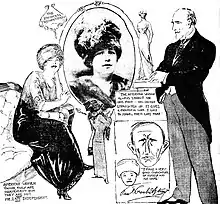Paolo Troubetzkoy
Prince Paolo Petrovich Troubetzkoy (also known as Pavel or Paul; Russian: Павел Петрович Трубецкой, romanized: Pavel Petrovich Trubetskoy; Intra, Italy, 15 February 1866 — Pallanza, 12 February 1938) was an artist and a sculptor who was described by George Bernard Shaw as "the most astonishing sculptor of modern times".[1][2] By birth, he was a member of the ancient House of Trubetskoy.



Life
He was the son of Russian diplomat, Prince Peter Petrovich Troubetzkoy and his second wife, lyric singer Ada Winans (1831-1917). His paternal grandmother was Princess Emilie zu Sayn-Wittgenstein-Sayn (1801-1869), which makes him great-grandson of famous Marshal Prince Peter zu Sayn-Wittgenstein-Berleburg-Ludwigsburg. He worked in Russia, the United States, England and Italy. He was a self-taught artist, although he learned sculpture from Giuseppe Grandi. He is associated with impressionism, due to his ability to grasp sketchy movements in his bronze works. He was heavily influenced by the work of Auguste Rodin and Medardo Rosso.[3] He depicted the society of the Belle Époque. Few of his bronzes are still available in the market. Quite famous is the 35 cm high portrait of Constance Stewart-Richardson called "The Dancer". His work was also part of the sculpture event in the art competition at the 1912 Summer Olympics.[4]
The largest and best known of his works is the monumental equestrian statue[5] of the Russian Tsar Alexander III in St. Petersburg, Russia. The monument was opened in 1909 on the Nevsky Prospekt near the Moskovsky Vokzal terminal. After the Russian revolution of 1917, the Soviet government removed the monument from the main street to the rear of the Russian Museum in St. Petersburg. After the dissolution of the Soviet Union, in 1994, the monument to Alexander was placed in front of the Marble Palace near the embankment of the Neva river, at the former site of the armoured car that transported Lenin from Finland Station.[6]
Vegetarianism
Troubetzkoy was a vegetarian. His vegetarian friend George Bernard Shaw remarked: “Troubetzkoy is a gigantic and terrifying humanitarian who can do anything with an animal except eat it”.[1][7]
Alexandra Tolstoy, daughter of the great novelist Leo Tolstoy wrote in her father’s biography: "From time to time he posed – a tiring obligation – for painters and sculptors: for Repin, Pasternak who did a study of the family, Aronson, and Paolo Troubetzkoy. Troubetzkoy, a Russian educated in Italy, did some splendid little statues of Tolstoy – one of him on horseback. Father was very fond of him. A sweet and childlike person in addition to his great gifts, he read practically nothing, spoke little, all his life was wrapped up in sculpture. As a convinced vegetarian he would not eat meat but cried: "Je ne mange pas de cadavre!" if anyone offered him some. In his studio in St. Petersburg there was a whole zoo: a bear, a fox, a horse, and a vegetarian wolf.[8]
Troubetzkoy once said “As I cannot kill I cannot authorize others to kill. Do you see? If you are buying from a butcher you are authorizing him to kill — kill helpless, dumb creatures, which neither I nor you could kill ourselves.”[9]
Personal life
Troubetzkoy was married twice. His first marriage was to a Swedish woman, Elin Sundström (1883–1927) and his second marriage was to a British woman named Muriel Marie Boddam. His son died at the age of 2 1/2 years - he sculpted in the same year the sculpture maternity.
Gallery
_-_BEIC_6330843.jpg.webp) Bust of Gabriele D'Annunzio, 1892. Vittoriale degli italiani, Gardone Riviera. Photo by Paolo Monti, 1969.
Bust of Gabriele D'Annunzio, 1892. Vittoriale degli italiani, Gardone Riviera. Photo by Paolo Monti, 1969. Isaac Levitan, 1899
Isaac Levitan, 1899 Princess M.N. Gagarina with her daughter, Marina, 1898
Princess M.N. Gagarina with her daughter, Marina, 1898
 Children (N.S and V.S Troubetzkoy), 1900
Children (N.S and V.S Troubetzkoy), 1900 Sergei Witte with his setter, 1901
Sergei Witte with his setter, 1901 Friends, 1901
Friends, 1901 Monument to Alexander III of Russia in front of the Marble Palace
Monument to Alexander III of Russia in front of the Marble Palace Lady Standing, 1927, Bass-Dwyer Collection
Lady Standing, 1927, Bass-Dwyer Collection
Expositions
- Paris Expo 1900 (gran premio). In: AIC
- De Young Museum (bust of Michael de Young)
- Biennale di Venezia 1922. (37 works).
- Galleria Nazionale (Rome)
- WWAA 1938
See also
References
- G.B. Shaw, Preface to the catalogue of an exhibition of sculpture by Troubetzkoy at the P. & D. Colnaghi Galleries, London, 1931, in The Complete Prefaces: 1930-1950 (Allen Lane, 1997), pp. 97-98.
- "Sale of the week: Troubetzkoy bronzes". Financial Times.
- Mackay, James, The Animaliers, E.P. Dutton & Co., 1973
- "Paolo Troubetzkoy". Olympedia. Retrieved 22 July 2020.
- The night view of the equestrian monument to Tsar Alexander III: see here
- Figes, Orlando: A People's Tragedy: The Russian Revolution 1891–1924. The Bodley Head, London (2014). p. 15.
- IVU Congress souvenir book (1957). Warriors for Vegetarianism.
- Alexandra Tolstoy, Tolstoy: A Life of my Father, London, 1953, p. 413.
- From an interview. Reported in The Vegetarian Magazine, Volume 11, Issue 2, 1907, p. 22. Also quoted in Gail Davis, Vegetarian Food for Thought, pp. 69, NewSage Press, 1999.
Further reading
- Prince Paul Troubetzkoy: The Belle Epoque Captured in Bronze. London: Sladmore Gallery. 2008. ISBN 978-1901403312.
External links
| Wikiquote has quotations related to: Paolo Troubetzkoy |
| Wikimedia Commons has media related to Paolo Troubetzkoy. |
